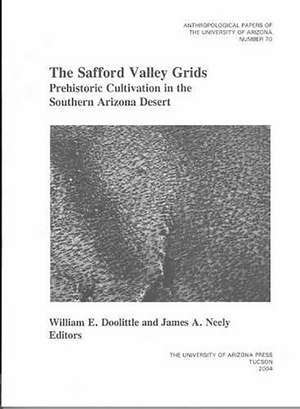The Safford Valley Grids: Prehistoric Cultivation in the Southern Arizona Desert: Anthropological Papers, cartea 70
Autor William E. Doolittle, James A. Neelyen Limba Engleză Paperback – 31 oct 2004
Crisscrossing Pleistocene terrace tops and overlooking the Gila River in southeastern Arizona are acres and acres of rock alignments that have perplexed archaeologists for a century. Well known but poorly understood, these features have long been considered agricultural, but exactly what was cultivated, how, and why remained a mystery. Now we know. Drawing on the talents of a team of scholars representing various disciplines, including geology, soil science, remote sensing, geographical information sciences (GISc), hydrology, botany, palynology, and archaeology, the editors of this volume explain when and why the grids were built.
Between A.D. 750 and 1385, people gathered rocks from the tops of the terraces and rearranged them in grids of varying size and shape, averaging about 4 meters to 5 meters square. The grids captured rainfall and water accumulated under the rocks forming the grids. Agave was planted among the rocks, providing a dietary supplement to the maize and beans that were irrigated on the nearby bottom land, a survival crop when the staple crops failed, and possibly a trade commodity when yields were high. Stunning photographs by Adriel Heisey convey the vastness of the grids across the landscape.
Between A.D. 750 and 1385, people gathered rocks from the tops of the terraces and rearranged them in grids of varying size and shape, averaging about 4 meters to 5 meters square. The grids captured rainfall and water accumulated under the rocks forming the grids. Agave was planted among the rocks, providing a dietary supplement to the maize and beans that were irrigated on the nearby bottom land, a survival crop when the staple crops failed, and possibly a trade commodity when yields were high. Stunning photographs by Adriel Heisey convey the vastness of the grids across the landscape.
Din seria Anthropological Papers
-
 Preț: 170.56 lei
Preț: 170.56 lei -
 Preț: 210.68 lei
Preț: 210.68 lei -
 Preț: 178.68 lei
Preț: 178.68 lei -
 Preț: 198.96 lei
Preț: 198.96 lei -
 Preț: 125.13 lei
Preț: 125.13 lei -
 Preț: 132.22 lei
Preț: 132.22 lei - 19%
 Preț: 270.60 lei
Preț: 270.60 lei - 21%
 Preț: 137.83 lei
Preț: 137.83 lei - 21%
 Preț: 137.91 lei
Preț: 137.91 lei - 21%
 Preț: 137.49 lei
Preț: 137.49 lei -
 Preț: 135.09 lei
Preț: 135.09 lei - 21%
 Preț: 138.63 lei
Preț: 138.63 lei - 18%
 Preț: 202.26 lei
Preț: 202.26 lei -
 Preț: 150.39 lei
Preț: 150.39 lei -
 Preț: 95.89 lei
Preț: 95.89 lei - 21%
 Preț: 149.85 lei
Preț: 149.85 lei - 20%
 Preț: 152.94 lei
Preț: 152.94 lei -
 Preț: 189.46 lei
Preț: 189.46 lei -
 Preț: 191.84 lei
Preț: 191.84 lei -
 Preț: 192.81 lei
Preț: 192.81 lei -
 Preț: 145.16 lei
Preț: 145.16 lei
Preț: 139.06 lei
Preț vechi: 174.99 lei
-21% Nou
Puncte Express: 209
Preț estimativ în valută:
26.62€ • 27.74$ • 22.16£
26.62€ • 27.74$ • 22.16£
Carte indisponibilă temporar
Doresc să fiu notificat când acest titlu va fi disponibil:
Se trimite...
Preluare comenzi: 021 569.72.76
Specificații
ISBN-13: 9780816524280
ISBN-10: 0816524289
Pagini: 194
Dimensiuni: 216 x 279 x 15 mm
Greutate: 0.55 kg
Ediția:New.
Editura: University of Arizona Press
Colecția University of Arizona Press
Seria Anthropological Papers
ISBN-10: 0816524289
Pagini: 194
Dimensiuni: 216 x 279 x 15 mm
Greutate: 0.55 kg
Ediția:New.
Editura: University of Arizona Press
Colecția University of Arizona Press
Seria Anthropological Papers
Notă biografică
William E. Doolittle is the Erich W. Zimmermann Regents Professor in Geography and the Chairman of the Department of Geography at The University of Texas at Austin and author of Cultivated Landscapes of Native North America. James A. Neely is Professor Emeritus of Anthropology and Archaeology at The University of Texas at Austin and the author of several publications on water management and irrigation in the American Southwest, Pueblo and Oaxaca in Mexico, and the Deh Luran Plain of Iran.
